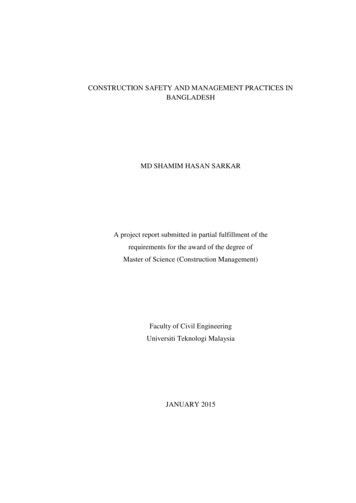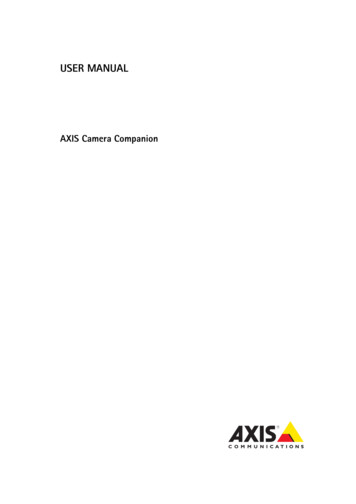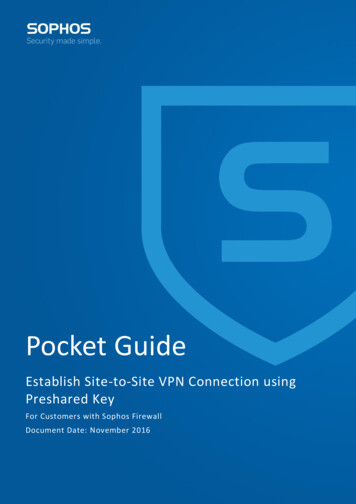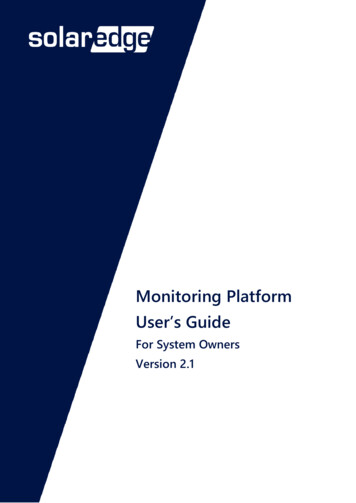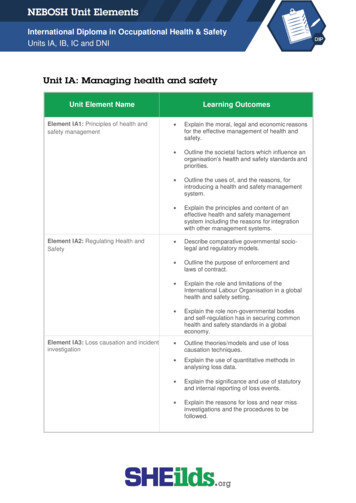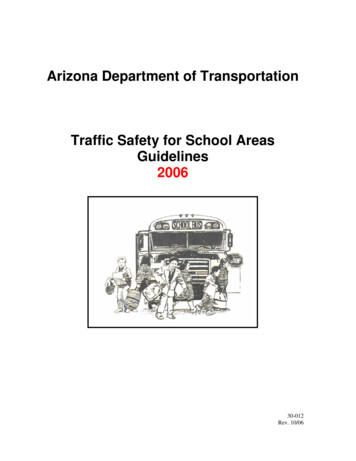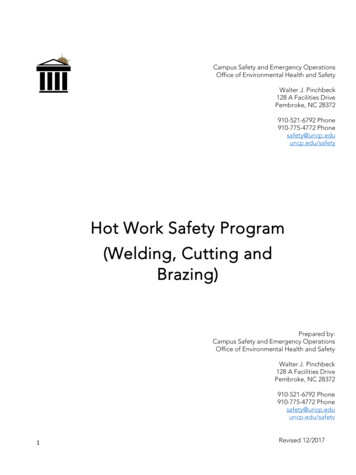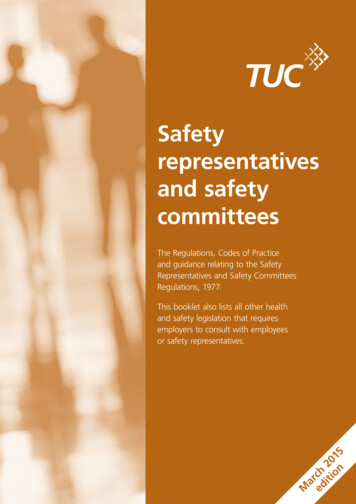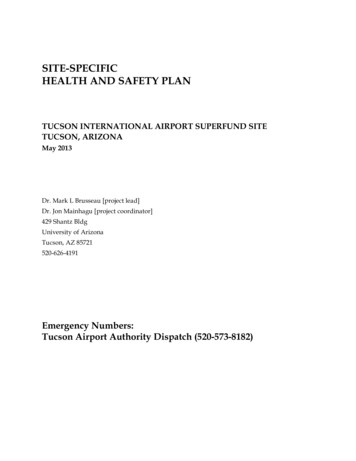
Transcription
SITE-SPECIFICHEALTH AND SAFETY PLANTUCSON INTERNATIONAL AIRPORT SUPERFUND SITETUCSON, ARIZONAMay 2013Dr. Mark L Brusseau [project lead]Dr. Jon Mainhagu [project coordinator]429 Shantz BldgUniversity of ArizonaTucson, AZ 85721520-626-4191Emergency Numbers:Tucson Airport Authority Dispatch (520-573-8182)
TABLE OF CONTENTSPage1.0INTRODUCTION . 11.1PURPOSE.11.2STOP WORK AUTHORITY .11.3PERSONNEL REQUIREMENTS .21.4PROJECT MANAGEMENT AND SAFETY RESPONSIBILITIES .21.5TRAINING REQUIREMENTS.31.5.1SITE-SPECIFIC TRAINING .31.5.2SAFETY MEETING/HEALTH AND SAFETY PLAN REVIEW .42.0SITE OPERATIONS . 52.1SCOPE OF WORK .53.0HAZARD EVALUATION . 63.1CHEMICAL HAZARDS .63.1.1CHEMICAL HAZARD CONTROLS .63.1.2SKIN CONTACT AND ABSORPTION CONTAMINANTS.73.1.3HAZARD COMMUNICATION.73.1.4FLAMMABLE AND COMBUSTIBLE LIQUIDS.73.2PHYSICAL HAZARDS .93.2.1HEAVY EQUIPMENT SAFETY AND DRILLING SAFETY .93.2.2NOISE.113.2.3UTILITY CLEARANCES .113.2.4VEHICLE TRAFFIC AND CONTROL .123.2.5MATERIAL HANDLING .123.2.6HEAVY LIFTING METHOD .133.2.7HAND AND POWER TOOLS.143.2.8EXCAVATIONS.143.2.9FALL HAZARDS .173.2.10SLIP/TRIP/HIT/FALL .173.2.11HEAT STRESS .173.2.12COLD STRESS.193.2.13ADVERSE WEATHER CONDITIONS.223.2.14HOT WORK HAZARDS .233.3BIOLOGICAL HAZARDS .243.3.1POISONOUS PLANTS .243.3.2INSECTS .243.3.3RODENTS.273.3.4SNAKES .284.0PERSONAL PROTECTIVE EQUIPMENT (PPE). 324.1GENERAL .324.2TYPES OF PERSONAL PROTECTIVE EQUIPMENT (PPE).324.2.1TYPES OF PROTECTIVE MATERIAL .334.3RESPIRATORY PROTECTION .344.3.1RESPIRATOR CLEANING .34-1-
4.44.4.1LEVELS OF PROTECTION.35REASSESSMENT OF PROTECTION LEVELS.355.0AIR MONITORING PROGRAM . 365.1EXPOSURE MONITORING .365.1.1PHOTOIONIZATION DETECTOR .365.1.2COMBUSTIBLE GAS/OXYGEN/CARBONMONOXIDE/HYDROGEN SULFIDE METERS .365.1.3MONITORING FREQUENCY.375.1.4HEALTH AND SAFETY ACTION LEVELS.376.0SITE CONTROL . 396.1COMMUNICATION .406.2BUDDY SYSTEM .416.2.1RESPONSIBILITIES .416.3SITE SECURITY .416.4DECONTAMINATION.426.4.1PERSONNEL AND EQUIPMENT DECONTAMINATIONPROCEDURES .427.0EMERGENCY PROCEDURES . 437.1ON-SITE EMERGENCIES .437.1.1ACCIDENT, INJURY, AND ILLNESS REPORTING ANDINVESTIGATION.447.2EMERGENCY EQUIPMENT/FIRST AID .447.3EMERGENCY PROCEDURES FOR CONTAMINATEDPERSONNEL.447.4SITE EVACUATION .457.5SPILL AND RELEASE CONTINGENCIES .458.0RECORDKEEPING. 46FCS 326 .ERROR! BOOKMARK NOT DEFINED.TRICHLOROETHYLENE . 11. PRODUCT IDENTIFICATION .12. COMPOSITION/INFORMATION ON INGREDIENTS .13. HAZARDS IDENTIFICATION.14. FIRST AID MEASURES .25. FIRE FIGHTING MEASURES .26. ACCIDENTAL RELEASE MEASURES .37. HANDLING AND STORAGE .38. EXPOSURE CONTROLS/PERSONAL PROTECTION .39. PHYSICAL AND CHEMICAL PROPERTIES.410. STABILITY AND REACTIVITY.411. TOXICOLOGICAL INFORMATION.412. ECOLOGICAL INFORMATION .513. DISPOSAL CONSIDERATIONS .514. TRANSPORT INFORMATION .515. REGULATORY INFORMATION .6-2-
16. OTHER INFORMATION.7NITROGEN. 8TRIFLUOROBROMOMETHANE . 9LIST OF APPENDICESAPPENDIX ACONTACT LIST AND MATERIAL SAFETY DATA SHEETS-3-
1.0INTRODUCTION1.1PURPOSEThe purpose of this site-specific health and safety plan (HASP) is to provide specificguidelines and establish procedures for the protection of personnel performing theactivities at the Tucon International Airport Authority (TIAA) Three Hangers Area Site.The information in this HASP has been developed in accordance with applicablestandards and is, to the extent possible, based on information available to date. TheHASP is also a living document in that it must continually evolve as site conditions andknowledge of the site work activities develop.A vital element of the Health and Safety Policies and Procedures is the implementationof a site-specific HASP for field activities. This HASP, as applicable to this project,includes the following measures: Communicate the contents of this HASP to site personnel. Eliminate unsafe conditions. Efforts must be initiated to identify conditions that cancontribute to an accident and to remove exposure to these conditions. Reduce unsafe acts. Personnel shall make a conscious effort to work safely. A highdegree of safety awareness must be maintained so that safety factors involved in atask become an integral part of the task. Inspect frequently. Regular safety inspections of the work site, materials, andequipment by qualified persons ensure early detection of unsafe conditions. Safetyand health deficiencies shall be corrected as soon as possible, or project activitiesshall be suspended. Documentation of daily inspections and corrective actionsshould be kept with the project files.1.2STOP WORK AUTHORITYAll project participants are empowered and expected to stop the work of co-workers,subcontractors, client employees, or other contractors if any person's safety or theenvironment are at risk. NO repercussions will result from this action.The discovery of any condition that would suggest the existence of a situation morehazardous than anticipated shall result in the removal of site personnel from that areaand reevaluation of the hazard and the levels of protection.-1-
1.3PERSONNEL REQUIREMENTSAll personnel conducting activities on site must conduct their activities in compliancewith all applicable Safety and Health legislation in the United States including, but notlimited to, the Occupational Safety and Health Administration (OSHA) 29 CFR 1910,29 CFR 1926, Tucson Airport Authority (TAA) rules and regulations, and polices andprocedures. Project personnel must also be familiar with the procedures andrequirements of this HASP. In the event of conflicting safety procedures/requirements,personnel must implement those safety practices, which afford the highest level of safetyand protection.1.4PROJECT MANAGEMENT AND SAFETY RESPONSIBILITIESPersonel Safety ResponsibilityAll personnel are responsible for their own safety as well as the safety of those aroundthem. Personnel shall use any equipment provided in a safe and responsible manner,and as directed.All personnel are directed to take the following actions when appropriate: Suspend any operations which may cause an imminent health hazard to employees,subcontractors, or others. Inspect tools and other equipment before each use or as manufacturer and/or OSHAdictates. Correct job site hazards when possible to do so, without endangering life or health. Report safety and health concerns to the SS or Site Supervisor (Jon Mainhagu, SWESDept. University of Arizona; 520-626-4191 or 520-576-0626).All personnel are required to act in a safe and responsible manner including: Think about how to avoid potential hazards associated with every action that you orothers may be involed in (before beginning that activity). Use caution and follow traffic requirements when driving to (and at) the site. Work with other team members when at the site to support the data collectionactivities at all times, and be aware and ready to make observations. Communicate with others (including the SS) any time you plan to leave the samplecollection area to use the rest room (treatment system control room) or get somefood/water.-2-
Communicate with others (and help to train coworkers) about workroles/responsibilities to maintain consistent work flow and transitions betweenshifts of teams with standardized sampling procedures and note taking. Try to work in an organized manner while maintaining a clean workingenvironment. If you have any free time, try to make sure the working area is clean. Field clothing should include long pants, long-sleeved shirt (if possible), andcomposite-toe or steel-toed boots. Use proper personal protection equipment (ppe) for your specific tasks whenworking at the site, and use decontamination when leaving the sample collectionarea. Hard-hats, safety glasses, and reflective vests should be worn in the vehicle and nearthe drilling operation. Safety glasses and nitrile gloves should be worn at all timeswhen sampling, transporting, or handeling site materials. Do not drink or eat within the sample collection area. We will have a water/reststation outside of the Three Hangers area. However, do not wander away from thesampling area and area south of the Three Hangers. Communicate with others and the SS if you have any problems or issues, and pleasebe on time to your work shifts.Equipment Operators - All equipment operators are responsible for the safe operationof heavy equipment. Operators are responsible for inspecting their equipment on adaily basis to ensure safe performance. Brakes, hydraulic lines, backup alarms, and fireextinguishers must be inspected routinely throughout the project. Documentation ofdaily inspections will be required. Equipment will be taken out of service if an unsafecondition occurs.Authorized Visitors - Shall be provided with all known information with respect to thesite operations and hazards as applicable to the purpose of their visit.1.5TRAINING REQUIREMENTS1.5.1SITE-SPECIFIC TRAININGPrior to working at this site, an initial site-specific training session or briefing shall beconducted prior to commencement of work activities. During this initial trainingsession, employees shall be instructed on the following topics: Personnel responsibilities;-3-
Content and implementation of the HASP; Description of assigned tasks/scope of work; Site hazards and controls; Site-specific hazardous procedures (e.g., lining activities, etc.); Coordination of Site activities; Training requirements; PPE requirements; Emergency information, including local emergency response team phone numbers,route to nearest hospital, accident reporting procedures, evacuation routes andprocedures, location of assembly points, and emergency response procedures; Instruction in the completion of required inspections and forms; and Location of safety equipment (e.g., portable eyewash, first aid kit, fire extinguishers,etc.).The various components of the project HASP will be presented followed by anopportunity to ask questions to ensure that each attendee understands the HASP.Personnel will not be permitted to enter or work in potentially contaminated areas of theSite until they have completed the Site-specific training session.In addition to the initial site briefing conducted at the commencement of the project,supplemental brief safety meetings shall be conducted by the Site Supervisor to discusspotential health and safety hazards associated with upcoming tasks, and necessaryprecautions to be taken.1.5.2SAFETY MEETING/HEALTH AND SAFETY PLAN REVIEW"Tailgate" safety meetings will take place each day prior to beginning the day's work.All Site personnel will attend these safety meetings, which may be contracted personnel,subcontractor personnel, or personnel from contractors working directly for the TAA.The safety meetings will cover specific health and safety issues, Site activities, changes inSite conditions, and a review of topics covered in the Site-specific pre-entry briefing.-4-
2.0SITE OPERATIONSSite operations will be conducted to address concentrations of chemical contaminants atthe Site.Figures 1 and 2 (see appendix) present the Site location and Site Plan, respectively.The Site is located at 900 South Susana Street just east of Old Nogales Highway. Accessto the Site can be made by traveling south from the University of Arizona on ParkAvenue with a left turn just south of the Three Hanger facility.Emergency evacuation to Kino Hospital:2800 E Ajo WayTucson, AZ 85713520-294-4471is by traveling north from the Site along Park (or Nogales Highway), turning right ontoAjo Way, and turning right into the hospital.2.1SCOPE OF WORKThis HASP covers the specific site activities that will be conducted by site personnel andtheir subcontractors. These activities are as follows:1. Mobilization and demobilization of personnel, materials, and equipment to the Site.This will involve the movement of necessary equipment, personnel and materials tothe project Site and the setup of temporary Site facilities. This may include the setupof staging/laydown areas, and any Site restoration activities.2. Soil vapor extraction system operation and data collection.3. Soil gas sample collection. May involve the injection of a tracer gas,TRIFLUOROBROMOMETHANE (MSDS in appendix)4. Discrete pressure measures.For the pressure measure, a double packer straddle system will be lowered insidethe monitoring well using a portable secured brake winch. The measuring protocol isas follows:‐Set up the holding structure and verify integrity‐Install the brake winch and the tubing wheel‐Assemble the straddle packer system and check connectivity for the transducer-5-
‐Attach the straddle packer system to the holding steel cable from the winch and controlthe carabiner‐Manually lower the straddle packer system inside the well‐Operate the winch to the proper depthHeavy equipment manual handled need to be done while respecting the Health AndSafety Procedure described in this document (section 3.2.1)3.0HAZARD EVALUATIONThis section identifies and evaluates the potential chemical, physical, and biologicalhazards, which may be encountered during the completion of this project.3.1CHEMICAL HAZARDSThe chemical hazards associated with conducting site operations include the potentialexposure to on-site contaminants encountered during field activities, such as chlorinatedhydrocarbon products, and support products such as fuel. The potential routes ofexposure from these products during normal use may occur through inhalation ofvapors/dusts or direct contact or absorption with the materials.3.1.1CHEMICAL HAZARD CONTROLSExposure to potential on-site chemicals, such as those listed in Appendix A – MSDSs Air Monitoring - Prior to entering the exclusion zone work area (or any otherrecognized hazardous area which includes confined spaces, excavations, etc.), airmonitoring shall be conducted in the breathing zone with a photoionization detectorand/or a four gas monitor capable of measuring for toxic gases, oxygen, combustiblegas, carbon monoxide, and hydrogen sulfide. Dust control measures, such as wetting the immediate area, shall be employed whenvisible dust is generated in active work areas. Using respiratory protection as appropriate, in areas known to have concentrationsabove the specified action level for each chemical.-6-
3.1.2SKIN CONTACT AND ABSORPTION CONTAMINANTSSkin contact with chemicals (solvents, injection chemicals, cement, etc.) may becontrolled by use of the proper PPE and good housekeeping procedures. The properPPE (e.g., Tyvek, gloves) as described in Section 4.0 shall be worn for all activities wherecontact with potentially harmful media or materials is anticipated. Utilize manufacturerdata on permeation and degradation to minimize skin contact potential (SeeSection 4.2.1 for additional information).3.1.3HAZARD COMMUNICATIONPersonnel required to handle or use hazardous materials as part of their job duties willbe trained and educated in accordance with the Hazard Communication standard asapplicable. The training shall include instruction on the safe usage and handlingprocedures of hazardous materials, how to read and access Material Safety Data Sheets(MSDSs), and the proper labeling requirements.The MSDSs with the appropriate MSDS for the chemicals in use at the site will beavailable to project personnel. A list of all MSDSs will be provided in Appendix A.Appropriate labels shall be maintained on all chemicals. All hazards for materials to bebrought on site and constituents expected to be encountered during the course of projectactivities will be identified by the program manager. At the end of the project, allhazardous materials brought on site will be taken off site.3.1.4FLAMMABLE AND COMBUSTIBLE LIQUIDSThe storage, dispensing, and handling of flammable and combustible liquids must be inaccordance with OSHA 29 CFR 1910.106, and NFPA guidelines and requires priorapproval of the TAA Fire Department. The specific flammable or combustible liquidsused at the site may include gasoline, diesel, kerosene, oils, and solvents.Flammable and combustible liquids are classified according to flash point. This is thetemperature at which the liquid gives off sufficient vapors to readily ignite. Flammableliquids have flash points below 100oF. (37.8 C). Combustible liquids have flash pointsabove 100 F (37.8 C) and below 200oF (93.3 C).-7-
StorageMany flammables can ignite at temperatures at or below room temperature. They arefar more dangerous than combustibles when they are heated. As a result, theseproducts must be handled very carefully. At normal temperatures, these liquids canrelease vapors that are explosive and hazardous to employee health. Exposure to heatcan cause some of these liquids to break down into acids, corrosives, or toxic gases.For this reason, flammable/combustible liquids should be stored in cool, well ventilatedareas away from any source of ignition. Always consult the MSDS of the product forspecific information.Flammable and combustible liquids must be stored in designated areas. Such areasmust be isolated from equipment and work activity, which may produce flames, sparks,heat or any form of ignition, including smoking. The most practical method is the use ofone or more approved (commercially available) flammable/combustible liquid storagecabinets.Cabinets must be labeled "Flammable – Keep Fire Away". Doors must be kept closedand labeled accordingly. Containers must be kept in the cabinet when not in use.General Requirements Keep containers of flammable/combustible liquids closed when not in use. Keep flammable/combustible liquids in designated areas and approved cabinets. Do not allow use of unapproved containers for transfer or storage. Use onlyapproved safety cans (5-gallon maximum) with a spring closing lid and spout cover,designated to safely relieve internal pressure when exposed to heat or fire. Use only approved self-closing spigots, faucets, and manual pumps when drawingflammable/combustible liquids from larger containers/barrels. Use only approved metal waste cans with lids for disposal of shop towels/oily rags. Designate "Smoking" and "No Smoking" areas. Designate fueling areas. Observe all signs indicating "No Smoking," "No Flames," "No Ignition."Transferring Flammable/Combustible Liquids This seemingly routine task can be hazardous if certain precautions are not followed.Grounding and bonding must be observed at all times to prevent the accumulationof static electricity when transferring contents of containers/barrels one to another.-8-
Drums should be grounded (#4 copper conductor) to a grounding rod. Bonding is necessary between conductive containers (e.g., a barrel and a 5-galloncontainer).3.2PHYSICAL HAZARDSPhysical hazards that may be present during project work include: proximity to heavyequipment, noise, overhead or under ground utilities, excavations, use of hand andpower tools, hot work (e.g. welding, cutting, and open flame), slip/trip/hit/fall injuries,electrical energy, stored energy (lockout/tagout), material handling, vehicle traffic,heavy lifting, biological hazards, heat stress, and other potential adverse weatherconditions. In addition, personnel must be aware that the protective equipment wornmay limit dexterity and visibility and may increase the difficulty of performing sometasks.3.2.1HEAVY EQUIPMENT SAFETY AND DRILLING SAFETYHeavy EquipmentThe following practices shall be adhered to by personnel operating heavy equipment(such as backhoes) and personnel working in the vicinity of heavy equipment: Heavy equipment is to be inspected when equipment is initially mobilized,delivered to a job Site, or after it is repaired and returned to service, to ensure that itmeets all manufacturer and OSHA specifications (e.g., fire extinguishers, backupalarms, etc.). Heavy equipment is to be inspected on a daily basis. Documentation of this dailypre-operational inspection is to be filed with the project files. Heavy equipment is only to be operated by authorized, competent operators. Seat belts are to be provided on heavy equipment that is not designed for stand-upoperation. Equipment/vehicles whose payload is loaded by crane, excavator, loader, etc. willhave a cab shield and/or canopy to protect the operator. Personnel will not be raised/lowered in buckets. Personnel will not ride on fender steps or any place outside the cab. Before leaving the equipment controls, ensure that the equipment is in its saferesting position. For a backhoe, apply the parking brake, put the front loader bucketdown on the ground level, and ensure that the rear excavator bucket is locked in the-9-
travel position. Bulldozers and scraper blades, loader buckets, dump bodies, andsimilar equipment will be fully lowered or blocked when not in use. Before raising any booms, buckets, etc., check for overhead obstructions. Employees involved in the operation shall not wear any loose-fitting clothing, as ithas the potential to be caught in moving machinery. Personnel shall wear high visibility safety vests, steel toed shoes, safety glasses,hearing protection, and hard hats during heavy equipment operations. When moving heavy equipment or when working within 10 feet of a stationaryobject or in tight quarters, a spotter will be used.Drilling EquipmentThe following practices shall be adhered to by drilling personnel: Equipment should be inspected daily by the operator to ensure that there are nooperational problems. The kill switch will be function-checked and verified to be operational during thedocumented daily equipment check. Personnel shall be instructed in the location and use of the emergency kill switch onthe drill rig. Employees involved in the operation shall not wear any loose-fitting clothing,including untied shoe/boot laces, draw strings, etc., which have the potential to becaught in moving machinery. Before leaving the controls, shift the transmission controlling the rotary drive intoneutral and place the feed lever in neutral. Before leaving the vicinity of the drill,shut down the drill engine. Before raising the mast, check for overhead obstructions. Before the mast of a drill rig is raised, the drill rig must first be leveled and stabilizedwith leveling jacks and/or cribbing. Re-level the drill rig if it settles after initialsetup. Lower the mast only when the leveling jacks are down, and do not raise theleveling jack pads until the mast is lowered completely. During freezing weather, do not touch any metal parts of the drill rig with exposedflesh. Freezing of moist skin to metal can occur almost instantaneously. Personnel shall wear steel toed shoes, safety glasses, hearing protection, and hardhats during drilling operations. The area shall be roped off, marked, or posted to keep the area clear of pedestriantraffic or spectators.- 10 -
3.2.2NOISEProject activities, such as use of power tools and material handling equipment, thatgenerate noise levels exceeding the decibel range (85dBA) will require the use of hearingprotection with a Noise Reduction Rating (NRR) of at least 20 when noise levels exceed85 dBA. Hearing protection (earplugs/muffs) will be available to personnel and visitorsthat would require entry into these areas.When it is difficu
Dept. University of Arizona; 520-626-4191 or 520-576-0626). All personnel are required to act in a safe and responsible manner including: Think about how to avoid potential hazards associated with every action that you or . others may be involed in (before beginning that activity).

